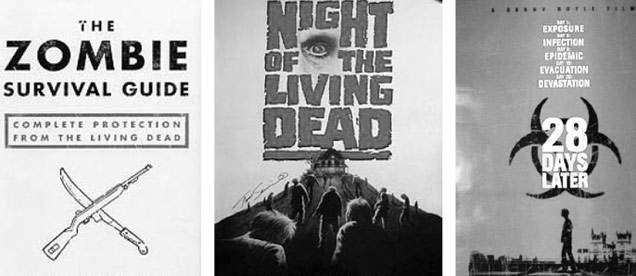All you need is brains
 CREDIT: UPLOAD.WIKIMEDIA.ORG / SIBATMEDIA.FILES.WORDPRESS.COM
CREDIT: UPLOAD.WIKIMEDIA.ORG / SIBATMEDIA.FILES.WORDPRESS.COMZombies: those pesky flesh-eating Hollywood monsters never seem to die, even after decapitation. From George A. Romero's classic slow-moving zombies to the infected undead of 28 Days Later and its sequel, the popular Hollywood depiction of the walking dead has lasted for more than four decades.
But when and where did this craze really start? Self-proclaimed zombie expert Bryan Holmes said, "It all started with (George A.) Romero, of course. He made movies that showed the ugliest of human nature." Romero's 1968 cult classic Night of the Living Dead was one of the first movies to depict what we could now refer to as "the Hollywood zombie."
"The word 'zombie' originally comes from the Kimbundu word 'nz�mbe,' a term describing a dead person's soul, and yes, zombies and zombification are integral parts of the Afro-Caribbean religion known as voodoo. However, the origin of their name is the only similarity between the voodoo zombie and the viral zombie," wrote Max Brooks in his New York Times bestselling book, The Zombie Survival Guide. By Brooks' definition, a "voodoo zombie" is created using "zombie powder." A voodoo priest would use the powerful neurotoxin to put his victim in a deathlike state, and the paralyzed human would be buried alive. What causes the zombielike state is brain damage from lack of oxygen. Brooks wrote that he believes that, unlike zombies shown in movies, voodoo zombies can think, feel pain and show emotion.
This version of the zombie is where movie producers found inspiration for the well-known flesh-eating ghouls we see on the big screen today. Former Fanshawe student Brian Gibson developed a zombie fascination after seeing Night of the Living Dead with his parents at a fairly young age. He also said he believes that zombies originated from old voodoo tales. "We always have stories about resurrection, people trying to bring others back from the dead. It was almost like a magician bringing back bodies to use, sort of like a puppeteer."
Zombie films always seem to experience a surge in popularity during times of uncertainty. In the '70s, with social uprising and the Vietnam and Cold Wars, fiction was something that people had some sort of control over and zombies were still something new and taboo that people could explore. Holmes said he believes that zombie gore is a metaphor for real life human struggles. "Most people miss the messages hidden in the films."
Eventually, zombie flicks shifted from being all about the hidden messages and the struggles of life to focusing on how much blood and guts you could show in one scene — which is not necessarily a bad thing. "You're thinking 'you shouldn't really be watching this' ... Which just makes it more interesting," Gibson added.
"There are a lot of different reasons that people find it interesting. I watch it for the relationships and the more human side of the plots," he said. "It's dealing with something that's really hard to grasp. People tend to reach out with humour to things that are hard to comprehend. It's just outside our scope of what could really happen," he added.
When reading and watching material based around fictional creatures like zombies, werewolves and vampires, it's important to remember that there is not and never will be one uniform story to describe where the folktale started or where it's going to end. By their very nature, fictional creatures are constantly evolving and new ones always developing. "It's been fascinating to see how big (the zombie craze) has gotten ... but I could see it getting even bigger," Gibson remarked.
Zombie films, survival guides, comic strips and Halloween costumes have become a big part of today's zombie culture, but perhaps one of the most important and popular things to have is a zombie survival plan. Holmes said he gets all his information from movies: "I would pretty much watch anything with the word 'zombie' in it, even the really bad films, and I would try to write down at least three things I would have done differently in their situation." He also joked that, "you are never safe, only safer. Whatever you choose — sealed-up Costco, island off the coast, mountain terrain — just remember to always have an exit strategy planned."
Sources for survival and education
Movies
Night of the Living Dead (1968 and its 1990 remake)
An unfortunate group finds themselves hiding in a farmhouse from flesh-hungry zombies.
Shaun of the Dead
This British zombie movie parody is sure to have you laughing while the undead prepare to attack.
Zombieland
An unlikely group joins together to travel across a zombie-infected America in a flick that will make you laugh and question their zombie-killing tactics.
Books
The Zombie Survival Guide by Max Brooks
This New York Times bestseller was written to keep you alive during the imminent zombie apocalypse.
Pride, Prejudice and Zombies by Jane Austen and Seth Grahame-Smith
A mash-up of the classic Pride and Prejudice and modern zombie fiction.
The Enemy by Charlie Higson
Set in a post-apocalyptic London, England, a group of children must live in an infected world where only adults become the enemy.
Extras
Resident Evil 2
Prepare your hunting skills by playing this older survival video game made for PlayStation. Resident Evil takes place in an American community infected by zombies.
Zombie Jerky
Stay nourished while on the run with this Teriyaki beef jerky made to look like zombie flesh.
Bed, Bath and Beyond's Zombie Squad hand sanitizer
A glow-in-the-dark hand sanitizer to keep your hands clean after all your zombie slaying.













